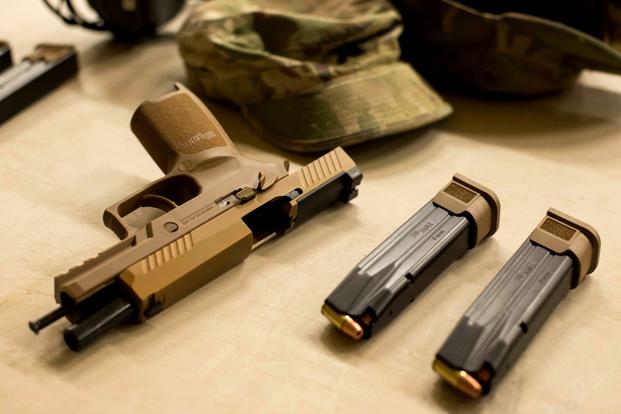NATIONAL HARBOR, Md. -- Marine Corps leaders today offered a glimpse into the service's decision to adopt the Army's Modular Handgun System as a replacement for its 9mm M9 pistol.
The Marines, along with the Navy and Air Force, are in the process of buying thousands of MHS pistols a little more than a year after the Army awarded Sig Sauer a $580 million MHS contract in January 2017.
The Marine Corps earmarked enough money in fiscal 2019 budget to buy 35,000 Modular Handgun Systems.
Anytime the Army moves in a direction, especially in small arms, the Marine Corps tries to follow as long as it makes sense, Brig. Gen. Joseph Shrader, commander of Marine Corps Systems Command, told Military.com at the annual Sea-Air-Space exposition on Wednesday.
"Frankly we have been asked by Congress to do that -- if the Army is going to go one way with something, the Marine Corps should have a good reason not to go the same way," Shrader said.
The Marine's decision to expand its fielding of the M27 Infantry Automatic Rifle to every Marine in the infantry squad is an example of when the Marines chose to go a different direction than the Army, Shrader said.
"We have determined that we have a requirement for that rifle," he said.
So far, Army officials maintain that the service is not interested in the M27 and will instead develop a next-generation squad weapon that potentially features case-telescoped ammunition.
"In a lot of our decisions, one of the things that really factors into the calculus very strongly is, what's the Army doing, and does it make sense for the Marine Corps to go that way with them. Or are there enough compelling reasons -- operational, business, all those things we look at -- that we stay our own path?" Shrader said.
"I think if we were to unpack [the MHS] decision from a requirements standpoint, I think we will find that there was not enough compelling reason there for us to stay with the Beretta," he added.
Sig Sauer beat out Glock Inc., FN America and Beretta in the MHS competition, an effort the Army launched in late August 2015. The striker-fired MHS pistols can be outfitted with suppressors and accommodate standard and extended-capacity magazines. There is also an accessory rail for mounting accessories such as weapon lights.
"When we purchase anything it's to make us more lethal; it's to make us more ready," said Sergeant Major of the Marine Corps Ronald Green.
But the decision also has to do with cost, Green said, referring to the deal the service is getting on MHS.
The Marine budget document does not provide a total dollar amount for the MHS, but lists the unit cost of 35,000 Sig Sauer MHS pistols at $180 each.
"We don't have an infinite amount of money," Green said. "We have to budget according to the budget that we have."
Green said he has not yet had the "opportunity to fire [the MHS], but I will be down at Quantico in a couple of months, and I will have the opportunity to do that."
The Navy plans to field 60,000 of the compact version of the MHS -- the XM18. The Marine Corps may decide to adopt only the XM18 as well, Shrader said.
"I know that we are looking at the compact version, I just don't know whether they have made that decision," Shrader said.
-- Matthew Cox can be reached at matthew.cox@military.com.










